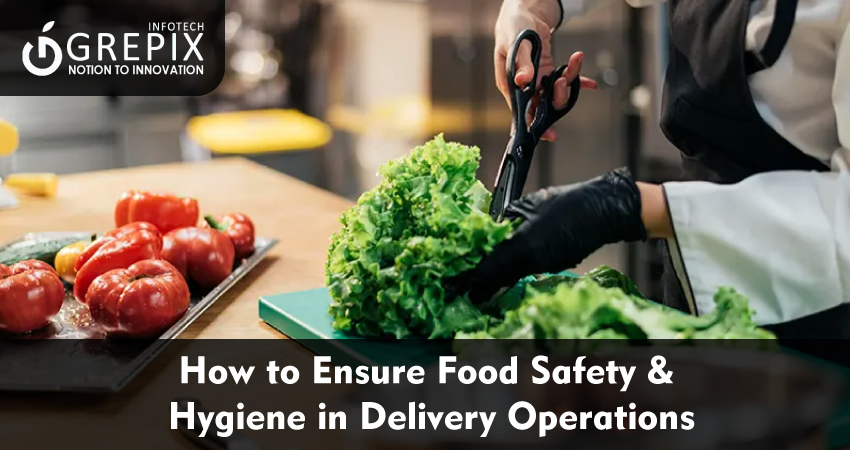How to Ensure Food Safety & Hygiene in Delivery Operations
Food safety in delivery has become a defining factor for customer trust and brand success. With over 2.6 billion consumers worldwide using online food delivery in 2025, maintaining high hygiene standards is more critical than ever. Safe food delivery operations not only protect end-users but determine the reputation and legal compliance of restaurants and delivery platforms. As customer expectations rise, businesses must adopt a hygiene-first approach, leveraging both best practices and smart tech solutions.
Food safety in delivery operations is a top concern for restaurants, customers, and delivery services in 2025. This guide dives deep into the importance of maintaining hygiene in food delivery, from kitchen to doorstep. It covers hygiene food delivery app features, training for riders, real-life outbreaks, and essential delivery hygiene standards. The article also breaks down technology solutions, global regulations, and case studies on safe food delivery operations. Businesses will discover actionable steps, practical checklists, and the latest compliance requirements to ensure a 5-star-safe customer experience. This article is essential reading for any restaurant, app developer, or food aggregator looking to boost trust and rank #1 for “food safety in delivery.” Share this resource to help make food delivery safer for everyone!
The Importance of Food Safety in Delivery
Protecting Health and Building Trust
Foodborne illnesses account for approximately 600 million cases and 420,000 deaths each year globally, with a growing share linked to food delivery chains. Ensuring hygiene in food delivery apps and operations is vital to prevent outbreaks and maintain public trust.
Real-World Example
In 2022, the city of Bengaluru recorded a significant foodborne illness spike traced to improper packaging and unhygienic delivery practices. The fallout cost delivery apps millions in customer refunds and brand reputation.
Key Reasons to Prioritize Hygiene
- Customer Confidence: Clean practices are often highlighted in customer reviews, directly impacting ratings and repeat business.
- Legal Compliance: Failing to meet delivery hygiene standards can result in fines, closures, and lawsuits.
- Competitive Advantage: Businesses with visible food safety protocols enjoy higher orders and customer loyalty.
- Health Impact: Vulnerable populations, such as children and the elderly, are especially at risk if food safety in delivery is neglected.
Hygiene in Kitchens: The First Line of Defense
Source Control: How Clean Kitchens Lay the Foundation
The quality of delivered food begins at the source. Hygiene food delivery apps are increasingly integrating kitchen audit features for real-time checks.
Essential Kitchen Hygiene Standards
- Staff Training: Every staff member must complete certified food safety training modules annually.
- Handwashing Protocols: Hand sanitizers, SOP posters, and sensor-enabled sinks are now commonplace.
- Ingredient Storage: FIFO (First-In, First-Out) ensures ingredients stay fresh, while temperature logs are mandatory.
- Equipment Sterilization: Utensils, prep tables, and packaging areas undergo disinfection after each use.
- Pest & Allergen Control: Kitchens use IoT-based sensors for pest alerts and allergen cross-contamination prevention.
Real-Life Example: McDonald’s Global Kitchen Audit
McDonalds implemented hourly hygiene checks and AI-powered sensors across its global kitchens, reducing contamination-related incidents by 35% in 2023.
Hygiene in Food Delivery: Seamless Safety from Kitchen to Doorstep
Delivery Personnel: The Hygiene Champions
Delivery riders are the critical link in safe food delivery operations. Untidy uniforms or lack of hygiene can compromise even the cleanest kitchen.
Top Hygiene Practices for Delivery Agents
- Full-sleeve uniforms and gloves are mandatory.
- Regular hand sanitization after each delivery.
- Masks worn properly at all times.
- Temperature checks before shift starts.
- No direct contact with food—sealed packaging is essential.
Safe Food Packaging Essentials
- Proper packaging is central to food safety in delivery:
- Leak-proof, tamper-evident containers.
- Types of packaging based on food category (hot, cold, allergen-sensitive).
- Packaging material must comply with food-grade standards.
- Use of QR codes for tracing and tamper-proof tape seals.
Case Study: Zomato’s Hygiene Push in India
After public pressure following a viral video of unsanitary food handling, Zomato launched a “Hygiene Badges” program. Outlets adopting strict delivery hygiene standards saw a 27% increase in orders and a sharp drop in complaints.
Tech Innovations for Hygiene Food Delivery Apps
Digital Solutions Keeping Deliveries Safe
Food safety in delivery is now driven by technology, making safe food delivery operations more efficient and transparent.
Popular Tech Features
- Temperature Monitoring: Smart packaging logs and records food temperature through delivery.
- Live Hygiene Scores: Apps show kitchen cleanliness ratings and rider health statuses in real-time.
- Geo-tracking: Monitors rider routes to ensure timely, safe delivery.
- AI for Predictive Hygiene Checks: Predicts when food might spoil en-route and sends alerts.
- Contactless Delivery: Limits interaction, reducing risk of contamination.
Example: Uber Eats’ ‘Food Safety Kit’
Uber Eats now mandates that all partners use the “food safety in delivery” kit, which includes real-time temperature sensors and tamper-proof bags. This program reduced in-transit spoilage complaints by 19%.
Delivery Hygiene Standards and Global Regulations
What the Law Requires
With the rise of food delivery, governments have updated regulations. Complying with national and international standards is crucial for all platforms.
Key Global Food Safety Standards
- HACCP (Hazard Analysis & Critical Control Points): A framework for identifying and controlling food safety risks.
- ISO 22000: Sets requirements for a food safety management system, covering end-to-end delivery.
- FSANZ (Australia), FSSAI (India), FDA (US): Country-specific protocols for food safety, packaging, and hygiene listing strict requirements for delivery personnel.
Case Study: FSSAI’s Hygiene Rating in India
The Food Safety and Standards Authority of India’s “Eat Right” hygiene rating is now compulsory for cloud kitchens and delivery aggregators. Businesses with a rating above 4 stars witnessed a 22% jump in app orders.
Essential Steps to Ensure Hygiene in Delivery Operations
Practical Checklist for Safe Food Delivery Operations
- Conduct regular kitchen and dispatch area audits.
- Mandate yearly hygiene training for all staff, including delivery riders.
- Enforce strict packaging guidelines—use only tamper-evident, food-grade materials.
- Integrate temperature logs in the hygiene food delivery app.
- Display updated hygiene ratings and allergen info in apps.
- Track rider health status and temperature at login.
- Respond to customer feedback with fast, transparent resolutions.
- Implement a checklist for every delivery: sealed packaging, rider hygiene, and temperature check.
Conclusion
Maintaining food safety in delivery ensures customer well-being, compliance, and business success. By establishing robust hygiene standards, leveraging smart tech, and staying ahead of evolving regulations, brands can build trust and grow their reach. Safe food delivery operations are no longer optional they’re a customer expectation and competitive necessity. Adopting hygiene food delivery app features, training delivery personnel, and following global benchmarks will keep operations safe and efficient.
Commit to safe food delivery review your standards now, boost customer loyalty, and make every order a safe delight. Share this article with industry peers and help set new delivery hygiene standards
FAQs
1. What are the major hygiene food delivery app features to look for?
Key features include real-time hygiene score display, temperature tracking, rider health updates, digital audit trails, and allergy information built into the ordering process.
2. How often should delivery vehicles and bags be cleaned?
Bags should be sanitized after every delivery, and vehicles deep-cleaned daily to maintain safe food delivery operations and meet delivery hygiene standards.
3. Which packaging materials are safest for food delivery?
Use only food-grade, tamper-proof, and temperature-retentive packaging. Cardboard, bioplastics, and recyclable materials are popular choices in safe food delivery operations.
4. Do food delivery operations need to comply with specific certifications?
Most regions require certification under HACCP or local food safety authorities (like FSSAI in India or FDA in the US) as part of delivery hygiene standards.
5. How can customers verify the hygiene of an order?
Many hygiene food delivery apps now offer live tracking for hygiene scores, and some use QR codes on packaging to verify that delivery hygiene standards are met in real-time.







